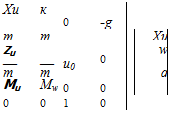6.3 Approximate Equations for the Longitudinal Modes 173
elegant result is not only of historical interest—it actually gives a reasonable approximation to the phugoid period of rigid airplanes at speeds below the onset of significant compressibility effects. Thus for the B747 example, the Lanchester approximation gives T = 107s, a value not very far from the true 93s. It is possible to get an even better approximation, one that gives an estimate of the damping as well. Because q is approximately zero in this mode, we can infer that the pitching moment is approximately zero—that the airplane is in quasistatic pitch equilibrium during the motion. Moreover the pitching moment can reasonably be simplified in these circumstances by keeping only the first two terms on the right side of (4.9,17e). Because q and w are both relatively small we further neglect Zq and as well. On making these simplifications to (4.9,18) and setting Af, = 0 and 6() = 0 we get the reduced system of equations:

![]() An
An
w
0
Afl
These equations are not in the canonical form x = Ax, but we can still get the characteristic equation by substituting x = x0eA’ and factoring out the exponential. The result is
|
(Xu/m – A) |
XJm |
0 |
-g |
|
ZJm |
{ZJm – A) |
n0 |
0 |
|
Mu |
Mw |
0 |
0 |
|
0 |
0 |
1 |
-A |
Equation (6.3,7) expands to
АЛ2 + ВЛ + С = 0
or A2 + 2£w„A + w2n = 0 (6.3,8) which is a convenient way to write the characteristic equation of a second-order system. The constants are
A = ~u0Mw
![]() В — gMu H {XUMW – MUXJ
В — gMu H {XUMW – MUXJ
m
c = – (zuMw – MUZJ m
from which we derive the radian frequency and damping to be
![]()
M, z
Table 4.4 with CZa = 0 is substituted into (6.3,12) we find (see Exercise 6.1) that Г„ = 1тгІ(оп is exactly the Lanchester period (6.3,5). Moreover if we make the further assumption that the airplane is a jet with constant thrust (dT/du0 = 0) we find the damping ratio to be that is, it is simply the inverse of the L/D ratio of the airplane. In fact the approximation for the period is good over the whole range of Cmu, whereas that for the damping is poor for large positive Cmu. For the example airplane the above approximation gives t, = 0.066, compared with the exact value 0.049.
SHORT-PERIOD MODE
Figure 6.3b shows that the short-period mode is essentially one with two degrees of freedom, the speed being substantially constant while the airplane pitches relatively rapidly. We can therefore arrive at approximate system equations by neglecting the X-force equation entirely and putting Ди = 0. Examination of the magnitudes of the terms in the numerical example shows that is small compared to m and Zq is small compared to mu0. The result after simplifying (4.9,18) with в0 = 0 is a pair of equations for w and q.
The characteristic equation of (6.3,13) is found to be
When converted with the aid of Tables 4.1 and 4.4, (6.3,14) becomes
A2 + BA + C = 0 (a)
|
В =—— t* |
|
r*2/’ |
 |
 |
|
where
When the data for the B747 is substituted into (6.3,15) the result obtained is
A2 + 0.741A + 0.9281 = 0 with roots A = —0.371 ± 0.889
which are seen to be almost the same as those in (6.2,3) obtained from the complete matrix equation. The short-period approximation is actually very good for a wide range of vehicle characteristics and flight conditions.











